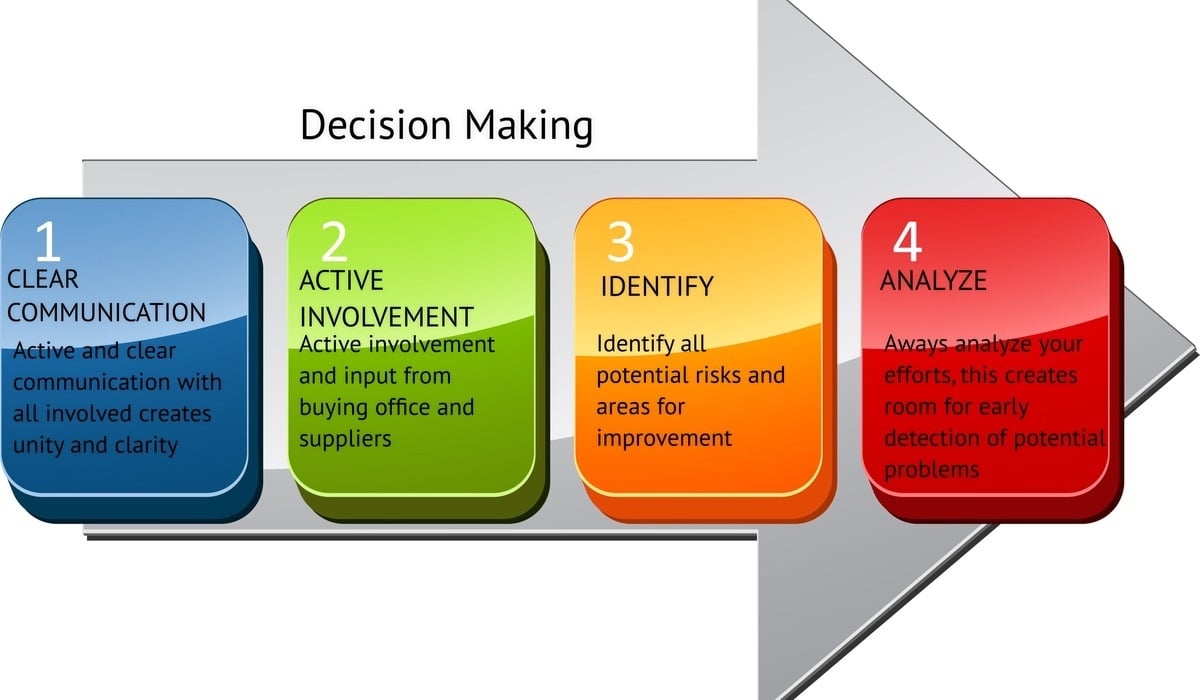Quality practices are essential to the success of your entire supply chain operation, knowing exactly what these practices are will help inform the steps you need to take in order to ensure success in your buying office.
There are a number of factors that affect the successful implementation of
quality practices in buying offices. In this blog post, we list seven supply chain management best practices that are critical success factors in ensuring successful operational efficiency.
1. A committed organization, from the board down
Organizations that actively encourage the involvement of buying offices in decision making and welcomes input from suppliers to identify areas for potential productivity improvements have the best chance of successful implementation. IKEA as a world renown furniture retailer is a great example of involving buying offices in the decision-making process. They have tried to create an integrated system where there is clear communication through the entire operation. We know that this method of organizational commitment has had incredible amounts of success and to always keep this in mind as you conduct your organizational operations.

There is evidence that supply chains are often managed functionally with metrics, systems, and behaviors geared to managing the performance of a specific area. Whilst detailed functional knowledge and understanding are essential to delivering a quality product, a narrow view can lead to a potential misalignment of the different elements of the chain towards the end goal. Senior management needs to ensure that decisions which are taken at the top are not sub-optimised in the operational execution. In practical terms, this means a real transformation in how measurement systems are designed and implemented to ensure that there is a full understanding of how the business interlinks. Individual incentives and success need to be aligned for the achievement of overarching goals, not purely functional excellence.
2. Effective program management
In order to successfully implement a quality management system there are three key lessons to keep in mind:
- Do not be too ambitious with the timing and expectations of rapid results. New process and systems need time to mature and the flexibility to adapt and change in order to achieve the required results.
- It becomes easy to set lofty targets but in order to see results, it is important to align the strategic requirements with the quality system functionality.
- Data accuracy is critically important. It is impossible to improve what isn’t measured so understanding which measures are helping improve quality and which aren’t are essential to helping buying office achieve the standards required.
Let’s take a look at LEGO, they underwent a full restructuring of their supply chain in order to begin optimizing their functions to remain a strong global competitor. They experienced excessive supply chain challenges that resulted in millions in revenue loss. They were aware that something needed to be done. With rapid globalization, adopting a flexible and integrated supply chain and network is essential to remain a strong competitor.
Check out our comprehensive guide to learn more about implementing a global quality assurance system.
3. Consistent, pre-emptive communications.
We have already discussed the importance of data and effectively communicating it with buying offices. Below are factors to consider:
 Be clear – This may sound like an obvious basic principle, but it’s vital to make sure the ‘narrative’ of the information comes across so that it is understood easier and its relevance and context are clear. Use a brief headline, to sum up, the information being communicated and focus on the key aspects of the data as well as why it is important and how it can be used.
Be clear – This may sound like an obvious basic principle, but it’s vital to make sure the ‘narrative’ of the information comes across so that it is understood easier and its relevance and context are clear. Use a brief headline, to sum up, the information being communicated and focus on the key aspects of the data as well as why it is important and how it can be used.- Tailor it – When getting across the key benefits of the project, don’t just focus on general benefits and costs. Consider the context of the buying office you are addressing and tailor it to show how to address their concerns.
- Be personal and pragmatic – It’s often more beneficial to convey information or communicate through direct channels, either in person or via the phone as opposed to less direct communication such as emails. A personal and pragmatic approach will get faster and better results when aiming to implement change.
The above factors create
transparency throughout the supply chain, more and more retailers are are beginning to harness the true power of effective and strong communication throughout the entire supply chain, from communication with material suppliers to actual manufacturers. Transparency and effective, clear communication creates a sense of trust through the supply chain which will essentially have effects throughout the entire operation.
4. Take positive action to identify and manage key risks before they become issues.

Retailers can protect themselves from potential supply chain interruptions or delays associated with suppliers’ human rights, labor, environmental, and governance practices by ensuring buying offices have effective compliance programs and robust management systems. Here are steps to manage risk:
- Align the buying office – Ensure that there is visibility and alignment of the value chain towards the ultimate goal of supplying the customer;
- Creating ownership beyond silos – There needs to be ownership of the whole chain, not just the buying office, in such a way which allows the risks along the chain to be tackled;
- Skills and capabilities to execute – The skills and competencies in each buying office must be secured. This starts with the functional skills in each area to provide the depth of executing a process.
Supply chains have become increasingly stretched not leaving much room for fault, therefore a successful risk management strategy can increase the effectiveness of your operation and minimize any identified or perceived risks.
5. Develop a framework with baseline targets, adapted as necessary.

Inaccurate data, existing systems infrastructure, and entrenched business practices are common barriers to the implementation of quality management systems. The importance of getting existing processes in line with
new technologies and methodologies serves to highlight the role of planning, as well as supporting the use of standardized frameworks for implementation. SCOR – The supply chain operations reference model, is a management tool that is used to address, improve, and communicate supply chain management decisions within a company and with suppliers and customers of a company. This model also helps to explain the processes along the entire supply chain and provides a basis for how to improve those processes.
Let’s look at an example from Apple: The technology producer developed a set of standards which is implemented across its supply chain. The result was a supply chain more in tune with its organizational goals to reduce waste and create more sustainable products which in turn create value for its customers. In the end, they diverted more than 73,000 metric tons of waste from landfills, saved more than 3.8 billion gallons of freshwater and prevented more than 13,800 metric tons of carbon emissions.
6. Create a succession of manageable delivery milestones to maintain momentum and build confidence.
Realistic expectations are important to ensure the successful implementation of quality initiatives. Overreaching in time or scope could mean failing to implement measures that otherwise would have worked. It is important to be
SMART:
Well defined goals, with consistent and measurable outputs, that are agreed to and attainable, that have the required resources to be
successfully completed, and have specified timelines are a way to ensure the implementation plan has manageable deliverables. This process ensures that expectations are managed and that buying offices have a clear understanding of how to achieve success. Every individual needs to be made aware of the overall goals, but also the goals that relate specifically to his/her involvement in the process.
7. An actionable, owned, manageable and measurable set of business benefits
Before the WHAT comes to the WHY. It is important for buying offices to understand WHY the
quality initiatives are being put in place. Getting their buy-in helps to ensure that everyone is “pulling the cart in the same direction”. Working for a specific cause creates a banner under which the value chain can unite. Once buying offices know WHY they are doing something they are more likely to support WHAT needs to be done. It is also important to ensure that the benefits are tangible. Buying offices should be able to quantify the benefits so that they stay motivated and focused on the initiatives they are implementing.
These quality practices are essential to the success of your entire supply chain operation, begin by analyzing whether any of these are currently being implemented. Analyze to what extent they are being integrated and begin optimizing these practices to ensure successful implementation of best practices. Have you implemented any of these? How have the been of benefit to you?
Need more help?
Check out our comprehensive guide to learn more about implementing a global quality assurance system.
 There is evidence that supply chains are often managed functionally with metrics, systems, and behaviors geared to managing the performance of a specific area. Whilst detailed functional knowledge and understanding are essential to delivering a quality product, a narrow view can lead to a potential misalignment of the different elements of the chain towards the end goal. Senior management needs to ensure that decisions which are taken at the top are not sub-optimised in the operational execution. In practical terms, this means a real transformation in how measurement systems are designed and implemented to ensure that there is a full understanding of how the business interlinks. Individual incentives and success need to be aligned for the achievement of overarching goals, not purely functional excellence.
There is evidence that supply chains are often managed functionally with metrics, systems, and behaviors geared to managing the performance of a specific area. Whilst detailed functional knowledge and understanding are essential to delivering a quality product, a narrow view can lead to a potential misalignment of the different elements of the chain towards the end goal. Senior management needs to ensure that decisions which are taken at the top are not sub-optimised in the operational execution. In practical terms, this means a real transformation in how measurement systems are designed and implemented to ensure that there is a full understanding of how the business interlinks. Individual incentives and success need to be aligned for the achievement of overarching goals, not purely functional excellence.
 Be clear – This may sound like an obvious basic principle, but it’s vital to make sure the ‘narrative’ of the information comes across so that it is understood easier and its relevance and context are clear. Use a brief headline, to sum up, the information being communicated and focus on the key aspects of the data as well as why it is important and how it can be used.
Be clear – This may sound like an obvious basic principle, but it’s vital to make sure the ‘narrative’ of the information comes across so that it is understood easier and its relevance and context are clear. Use a brief headline, to sum up, the information being communicated and focus on the key aspects of the data as well as why it is important and how it can be used. Retailers can protect themselves from potential supply chain interruptions or delays associated with suppliers’ human rights, labor, environmental, and governance practices by ensuring buying offices have effective compliance programs and robust management systems. Here are steps to manage risk:
Retailers can protect themselves from potential supply chain interruptions or delays associated with suppliers’ human rights, labor, environmental, and governance practices by ensuring buying offices have effective compliance programs and robust management systems. Here are steps to manage risk:
 Inaccurate data, existing systems infrastructure, and entrenched business practices are common barriers to the implementation of quality management systems. The importance of getting existing processes in line with new technologies and methodologies serves to highlight the role of planning, as well as supporting the use of standardized frameworks for implementation. SCOR – The supply chain operations reference model, is a management tool that is used to address, improve, and communicate supply chain management decisions within a company and with suppliers and customers of a company. This model also helps to explain the processes along the entire supply chain and provides a basis for how to improve those processes.
Let’s look at an example from Apple: The technology producer developed a set of standards which is implemented across its supply chain. The result was a supply chain more in tune with its organizational goals to reduce waste and create more sustainable products which in turn create value for its customers. In the end, they diverted more than 73,000 metric tons of waste from landfills, saved more than 3.8 billion gallons of freshwater and prevented more than 13,800 metric tons of carbon emissions.
Inaccurate data, existing systems infrastructure, and entrenched business practices are common barriers to the implementation of quality management systems. The importance of getting existing processes in line with new technologies and methodologies serves to highlight the role of planning, as well as supporting the use of standardized frameworks for implementation. SCOR – The supply chain operations reference model, is a management tool that is used to address, improve, and communicate supply chain management decisions within a company and with suppliers and customers of a company. This model also helps to explain the processes along the entire supply chain and provides a basis for how to improve those processes.
Let’s look at an example from Apple: The technology producer developed a set of standards which is implemented across its supply chain. The result was a supply chain more in tune with its organizational goals to reduce waste and create more sustainable products which in turn create value for its customers. In the end, they diverted more than 73,000 metric tons of waste from landfills, saved more than 3.8 billion gallons of freshwater and prevented more than 13,800 metric tons of carbon emissions.
